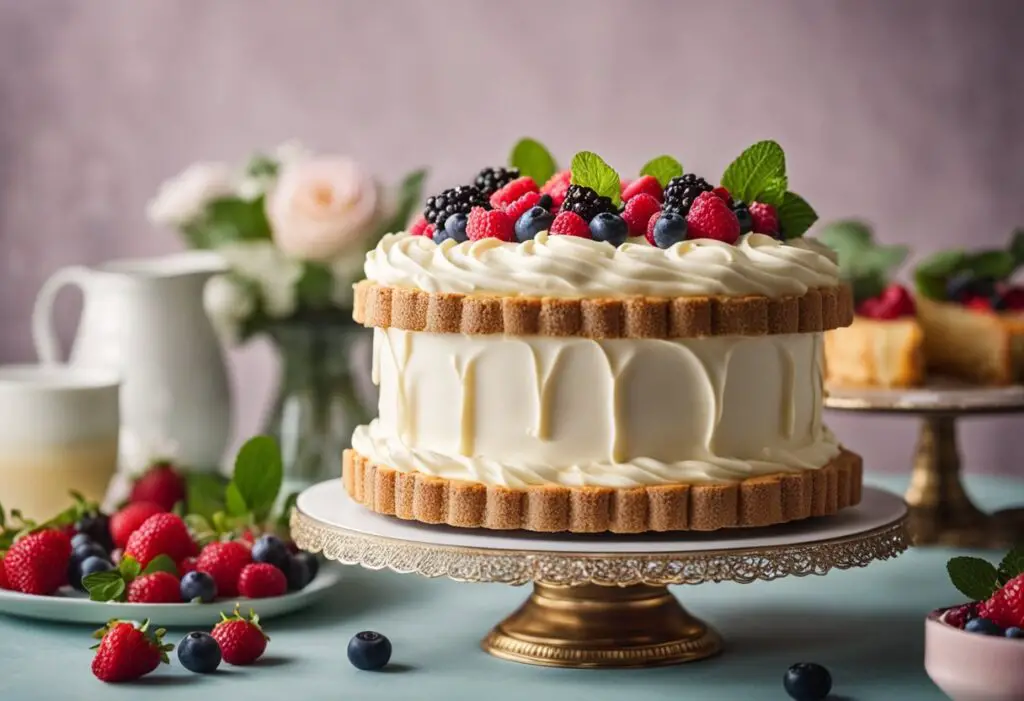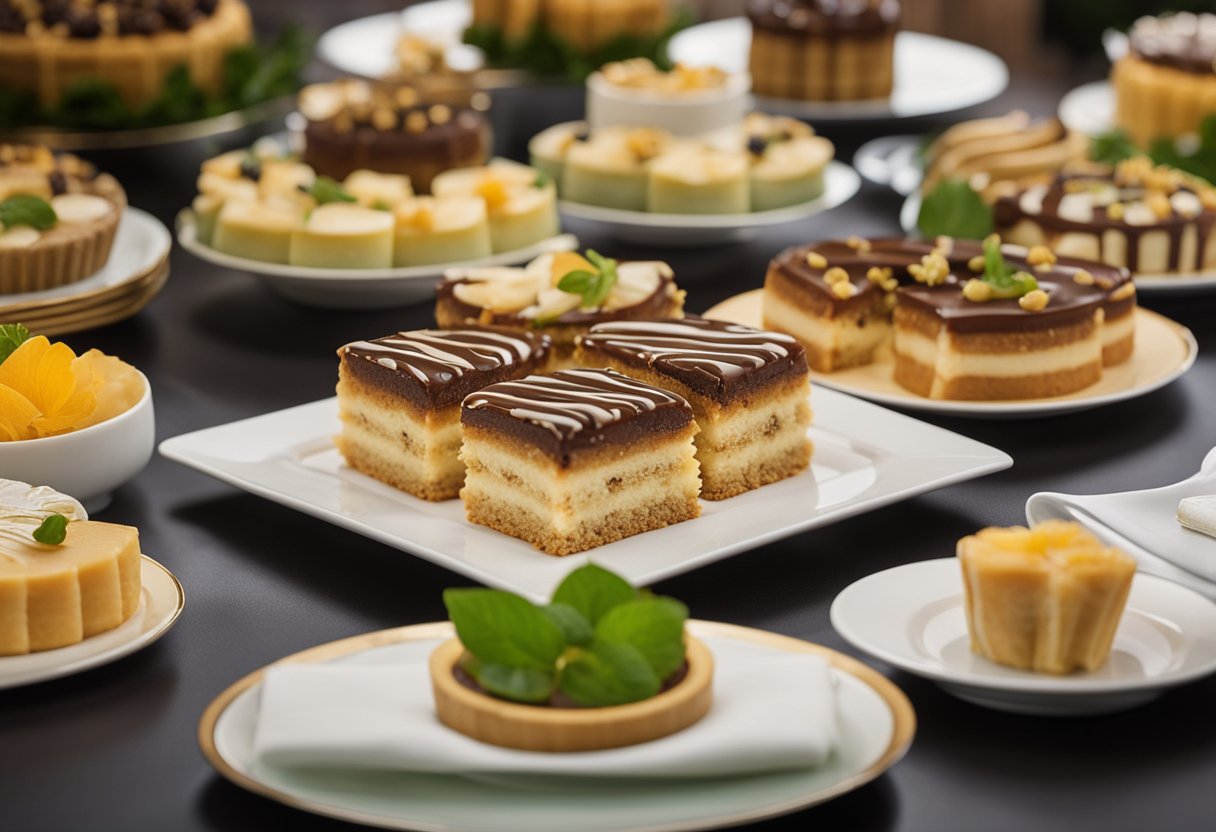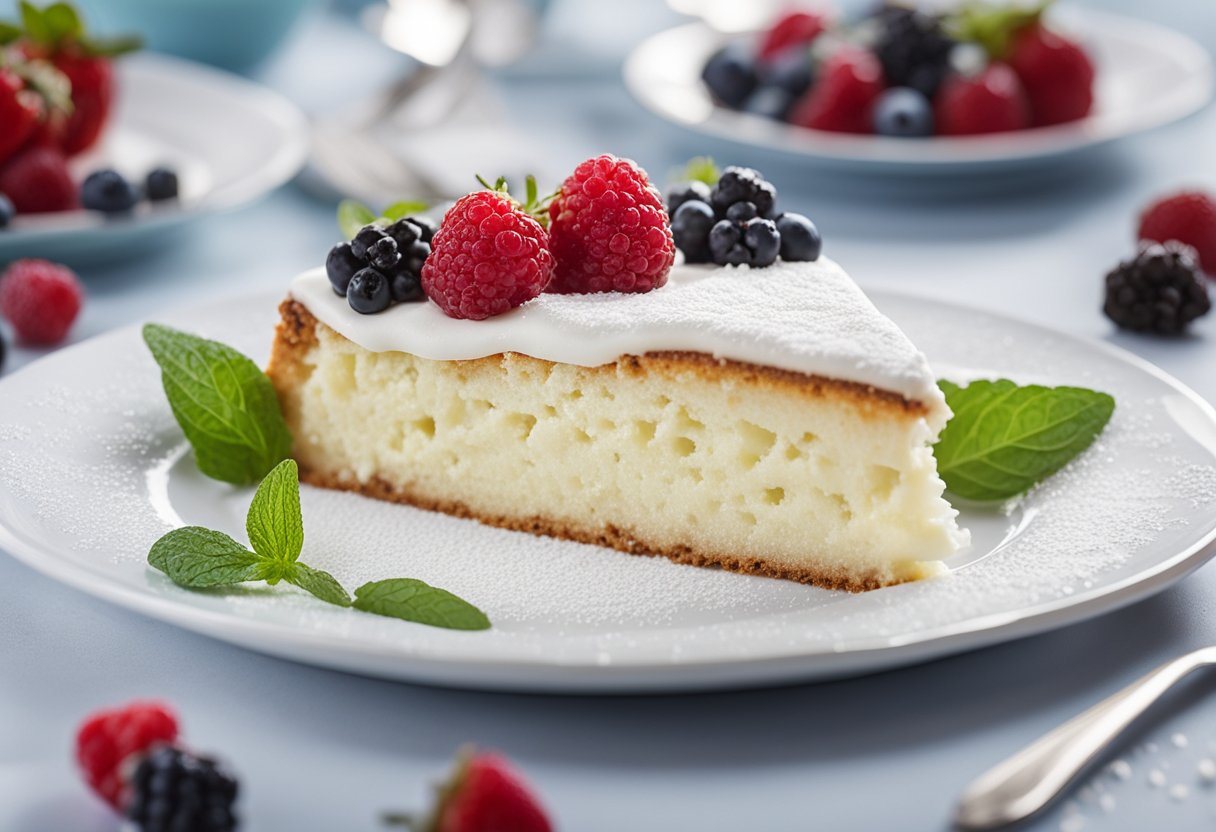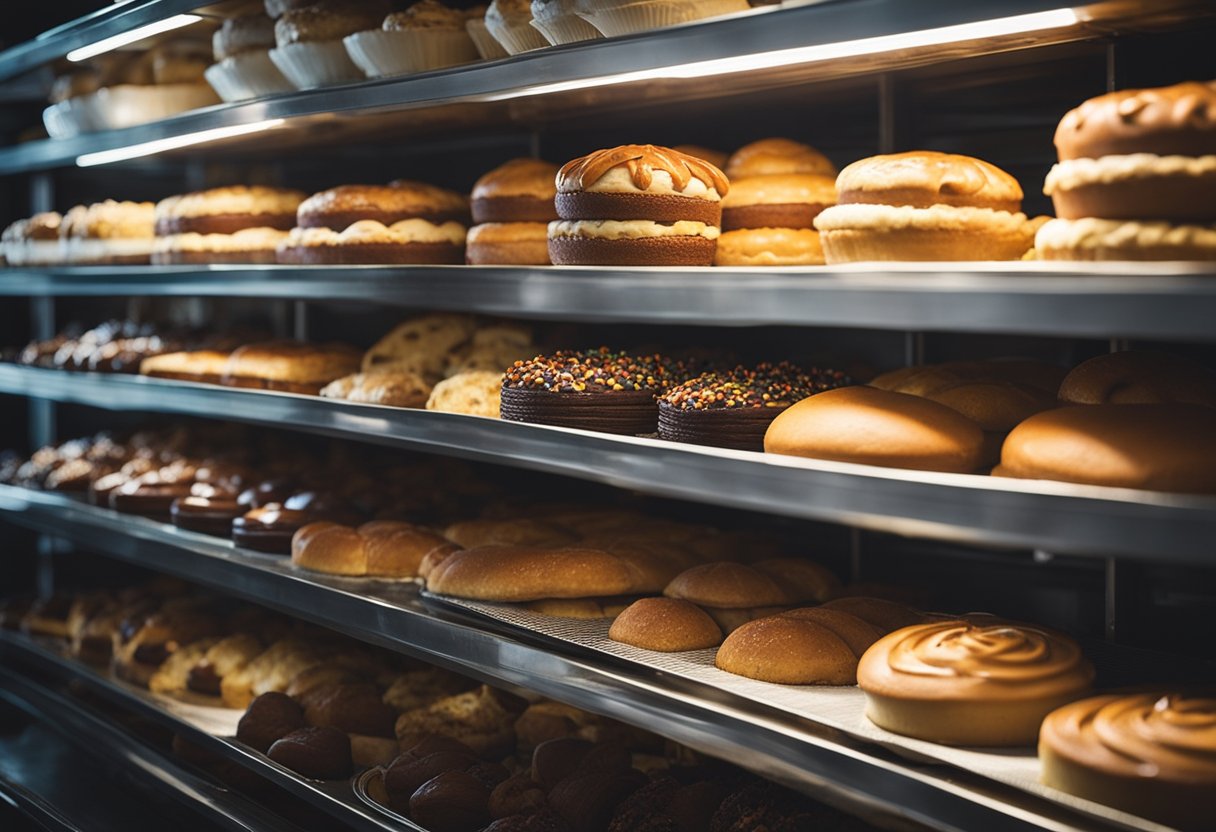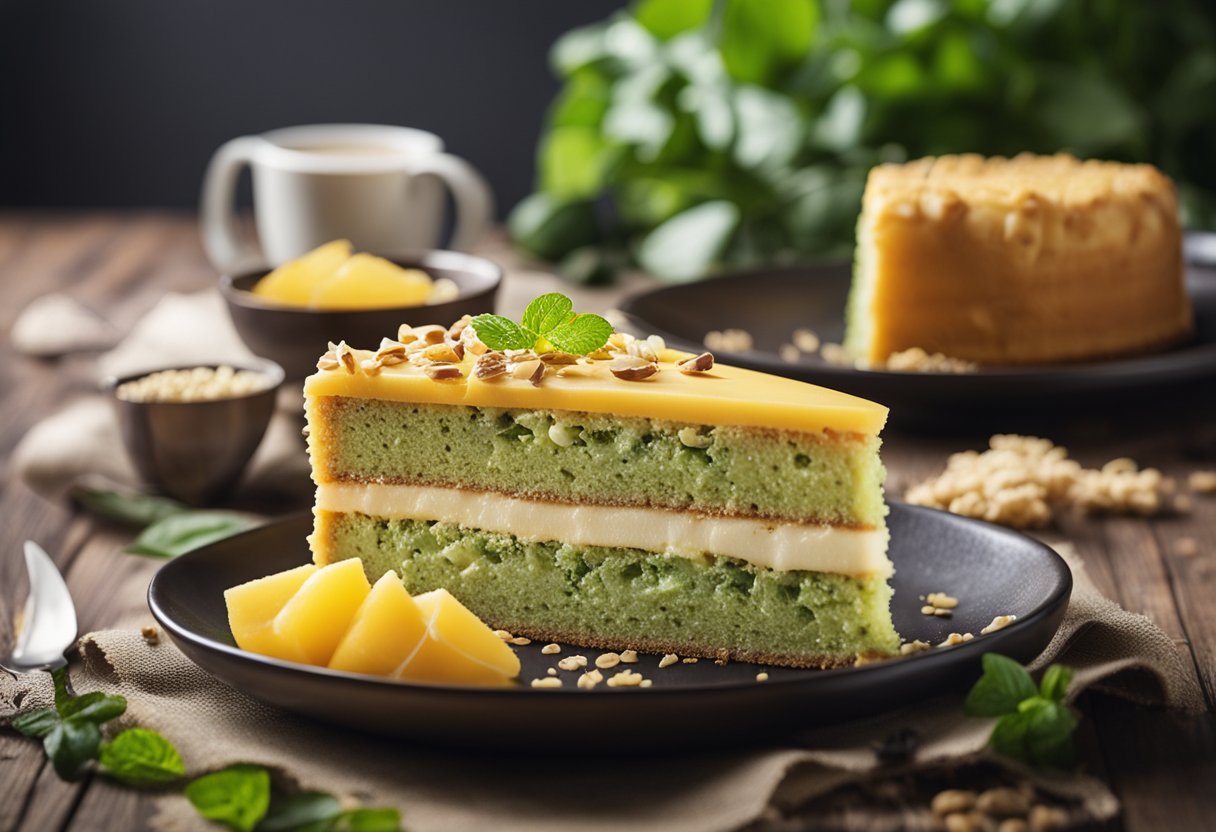If you’re looking for a light and airy dessert that’s perfect for any occasion, look no further than Savoy cake. This French classic is a fatless sponge cake that’s easy to make and customize with different flavors and fillings. Whether you’re a beginner baker or an experienced pro, you can create a delicious Savoy cake that will impress your friends and family.
The origins of Savoy cake can be traced back to the 18th century in the Savoy region of France. This dessert cake was traditionally baked in an ornate mold and filled with whipped cream and fresh fruit. Today, there are many variations of Savoy cake, including chocolate, lemon, and almond. You can also add your own twists to the recipe by using different fillings, such as jam or buttercream frosting.
One of the unique features of Savoy cake is that it contains no fat. Instead, it gets its light and fluffy texture from whipped egg whites. This makes it a healthier option than many other cakes, while still being delicious and satisfying. So whether you’re looking for a dessert to impress your guests or just want to treat yourself to something sweet, Savoy cake is a great choice.
History of Savoy Cake
Savoy cake is a classic cake that has been enjoyed for centuries. It is named after the Savoy Region in what is now France, where it is believed to have originated. The cake is made with a few simple ingredients, including eggs, sugar, and flour. It is known for its light and fluffy texture, which is achieved by whisking the eggs and sugar together.
The origins of Savoy cake date back to the 18th century. The cake was originally used to make sponge-finger biscuits, which were popular in Europe at the time. The recipe for the cake was later adapted to make larger, more ornate cakes. The original molds used to make the cakes were made of copper, and preparing them to ensure all cakes turned out without breaking must have been a stressful undertaking.
Over time, Savoy cake became a popular dessert in many parts of the world. It was particularly popular in the Victorian era in the United Kingdom, where it was served at the famous Savoy Hotel in London. The cake’s unique baking technique, which involves whisking the eggs and sugar together to create a light and fluffy texture, made it a favorite among bakers and pastry chefs.
Today, Savoy cake is still enjoyed by people all over the world. It is a simple yet delicious dessert that can be served on its own or with a variety of toppings, such as whipped cream, fresh fruit, or chocolate sauce. Whether you are a seasoned baker or a novice, Savoy cake is a classic dessert that is sure to impress your guests and satisfy your sweet tooth.
Basic Ingredients
If you want to bake a delicious Savoy cake, you need to start with the right ingredients. Here are the basic ingredients you’ll need:
1. Eggs
Eggs are the main ingredient in Savoy cake. They provide the structure and texture of the cake. You’ll need four large eggs for this recipe. Make sure the eggs are at room temperature before you start baking.
2. Sugar
Sugar adds sweetness to the cake and helps to create a light, fluffy texture. You’ll need about 80g of blond cane sugar for this recipe.
3. Flour
Flour is used to add structure to the cake. You’ll need about 40g of flour for this recipe.
4. Starch
Potato starch is used to create a light, airy texture in the cake. You’ll need about 40g of starch for this recipe.
5. Lemon zest
Lemon zest adds a fresh, zesty flavor to the cake. You’ll need the zest of one unprocessed organic lemon.
6. Butter
Butter is used to grease the cake tin. You’ll also need some melted butter to brush onto the tin.
7. Icing sugar
Icing sugar is used to decorate the cake. You can dust it over the top of the cake before serving.
Overall, these ingredients are simple and easy to find. With just a few basic ingredients, you can create a delicious Savoy cake that everyone will love.
Preparation Techniques
Mixing Methods
To make a perfect Savoy cake, you need to mix the ingredients properly. The mixing process involves folding in the egg whites to the batter, which creates a light and fluffy texture. You can use either the French or the Italian method to mix the batter. The French method involves mixing the egg yolks with sugar, followed by the addition of flour and whipped egg whites. The Italian method involves making a meringue with egg whites and sugar, which is then folded into the egg yolks and flour mixture. Both methods yield excellent results, so choose the one that you are most comfortable with.
Baking Temperatures
The baking temperature for a Savoy cake is crucial. The ideal temperature is 160°C to 180°C, depending on your oven. Baking at a higher temperature will cause the cake to rise too quickly and then collapse, resulting in a dense cake. Conversely, baking at a lower temperature will cause the cake to take longer to cook, resulting in a dry and tough cake. To ensure that your cake is cooked evenly, rotate the pan halfway through the baking time.
Molding and Shaping
Savoy cake is traditionally baked in a decorative Bundt mold. However, you can also use a regular cake pan or a springform pan. To prevent the cake from sticking to the pan, grease the pan with butter and dust it with flour. You can also use parchment paper to line the bottom of the pan. Once the cake is baked, let it cool in the pan for 10 minutes before removing it. To remove the cake from the pan, run a knife around the edges of the cake to loosen it, then invert the pan onto a wire rack.
Variations of Savoy Cake
Savoy cake is a light, airy sponge cake that can be enjoyed on its own or with various toppings and fillings. Here are some ideas for variations of savoy cake to add a personal touch to this classic dessert.
Flavor Additions
Savoy cake can be flavored with a variety of ingredients to add a unique twist to the classic recipe. Some popular flavor additions include:
- Lemon zest: Add 1-2 tablespoons of finely grated lemon zest to the batter for a light, citrusy flavor.
- Almond extract: Replace the vanilla extract with almond extract for a nutty, sweet flavor.
- Cocoa powder: Add 1/4-1/2 cup of unsweetened cocoa powder to the batter for a rich, chocolatey flavor.
- Matcha powder: Add 1-2 tablespoons of matcha powder to the batter for a unique, earthy flavor.
Decorative Styles
Savoy cake can also be decorated in various ways to make it visually appealing. Here are some decorative styles to consider:
- Fruit topping: Top the cake with fresh fruit, such as strawberries, raspberries, or kiwi slices, for a colorful and refreshing finish.
- Whipped cream: Spread whipped cream over the cake and decorate with fresh berries or chocolate shavings for an elegant look.
- Glaze: Drizzle a simple glaze made of powdered sugar and milk over the cake for a glossy finish.
- Powdered sugar: Dust the cake with powdered sugar for a classic, simple finish.
Experiment with different flavor additions and decorative styles to create your own unique variation of savoy cake. With its light texture and endless possibilities, savoy cake is a dessert that can be enjoyed all year round.
Serving and Presentation
Now that you have baked the perfect Savoy cake, it is time to serve and present it in an elegant and appetizing way.
Firstly, let the cake cool completely before removing it from the pan. Use a sharp knife to loosen the cake from the edges of the pan, and then invert it onto a wire rack to cool. Once cooled, you can trim the top of the cake to create a level surface for decorating.
Next, you can decorate the cake with whipped cream and fresh fruit, such as strawberries, raspberries, or blueberries. You can also dust the cake with icing sugar for a finishing touch.
To serve the cake, you can cut it into slices using a sharp knife. You can also garnish each slice with a small dollop of whipped cream and a fresh berry.
For a more sophisticated presentation, you can serve the cake on a decorative cake stand or platter. You can also add a few fresh flowers or greenery around the base of the cake to add a pop of color.
Remember, the presentation of your Savoy cake is just as important as its taste. With a little bit of creativity and attention to detail, you can create a beautiful and delicious dessert that is sure to impress your guests.
Storage and Shelf Life
Savoy cake is a delicate dessert that requires proper storage to maintain its texture and freshness. Here are some tips for storing your savoy cake:
- Room Temperature: Savoy cake can be stored at room temperature for up to two days. Wrap the cake tightly in plastic wrap or aluminum foil to prevent it from drying out.
- Refrigeration: If you want to store your savoy cake for longer than two days, refrigeration is the best option. Cover the cake with plastic wrap or aluminum foil and store it in the refrigerator for up to a week.
- Freezing: Savoy cake can also be frozen for up to three months. Wrap the cake tightly in plastic wrap and aluminum foil, or place it in an airtight container before freezing. Thaw the cake in the refrigerator overnight before serving.
It’s important to note that the texture of savoy cake may change slightly after being stored in the refrigerator or freezer. However, it will still be delicious and enjoyable to eat.
To ensure the longest shelf life possible, it’s best to store savoy cake in a cool, dry place away from direct sunlight, heat, and moisture. Avoid storing the cake near strong-smelling foods as it can absorb their odors.
By following these simple storage tips, you can enjoy your savoy cake for longer without sacrificing its quality and taste.
Unveiling the Artistry of Savory Cakes
Savory cakes offer a unique blend of flavors, turning the ordinary into extraordinary. At Gourmet Martha, we pride ourselves on pushing culinary boundaries, and our collection of recipes reflects just that. Let’s dive into the savory wonders that await you:
Grandma’s Sour Cream Pound Cake: A Timeless Classic
Grandma’s Sour Cream Pound Cake is a testament to the rich heritage of family recipes. Infused with the warmth of nostalgia, this cake promises a velvety texture and a symphony of flavors that dance on your palate.
Grandma’s Sour Cream Pound Cake holds the secret to a perfect afternoon treat or a delightful dessert for any occasion.
Zucchini Brownies: Where Health Meets Indulgence
Healthy meets indulgence in our Mom’s Zucchini Bread and Zucchini Brownies. These creations redefine the concept of guilt-free indulgence, turning garden-fresh zucchinis into moist, chocolatey delights that will surprise and satisfy even the most discerning sweet tooth.
Experience the magic: Mom’s Zucchini Bread | Zucchini Brownies
Fusion Flavors: Grilled Cajun Lemon Shrimp
Take a detour from traditional desserts and embark on a savory adventure with Grilled Cajun Lemon Shrimp. This dish combines the bold flavors of Cajun seasoning with the zesty kick of lemon, creating a tantalizing symphony for your taste buds.
Embark on the journey: Grilled Cajun Lemon Shrimp
Elevate Your Culinary Repertoire with Gourmet Martha’s Collection
Discover the versatility of our recipes, each crafted with precision and passion. From the luscious Strawberry Lasagna to the tempting Blueberry Bottom Cake, Gourmet Martha’s repertoire promises a culinary experience like no other.
Indulgence Redefined: Chocolate Mud Bars
Dive into the world of decadence with our Chocolate Mud Bars. Rich, gooey, and utterly irresistible, these bars are a chocolate lover’s dream come true. The perfect treat for those seeking an escape into indulgence.
Chocolate Mud Bars: Because sometimes, a little decadence is all you need.
Quinoa Salad with Tomato and Avocado: A Refreshing Twist
For those craving a savory escape from the ordinary, our Quinoa Salad with Tomato and Avocado is a refreshing delight. Packed with wholesome ingredients, this salad is a celebration of vibrant flavors and nutritious goodness.
Savor the freshness: Quinoa Salad with Tomato and Avocado
What is a Victorian Savoy Cake?
A Victorian Savoy Cake is a confectionary marvel that hails from the grandeur of the Victorian era. This sponge cake, characterized by its light and airy texture, was a staple at high tea gatherings and aristocratic soirées.
Old-Fashioned Savoy Cake:
The term “Old-fashioned Savoy Cake” encapsulates the enduring appeal of this timeless treat. Rooted in tradition and bereft of modern embellishments, an Old-fashioned Savoy Cake celebrates simplicity and the pure, unadulterated flavors of its era. Whether enjoyed with a cup of tea or as a dessert centerpiece, this classic rendition transports taste buds to a bygone culinary epoch.
Why was the Savoy Cake Inedible?
In the annals of culinary history, there exists a peculiar chapter that recounts a time when the Savoy Cake faced an unexpected setback—its inedibility. Some historical accounts suggest that due to variations in recipes and techniques, certain renditions of the Savoy Cake fell short of the expected culinary delight. Factors such as improper ingredient proportions or inadequate
Nutritional Information
Savoy cake is a light and airy sponge cake that is typically made with flour, sugar, and eggs. It is a delicious dessert that can be enjoyed on its own or with a variety of toppings, such as fresh fruit or whipped cream.
If you are watching your calorie intake, it is important to note that Savoy cake is not a low-calorie dessert. One serving of Savoy cake, which is typically around 100 grams, contains approximately 280-300 calories. This is due to the high sugar and flour content in the cake.
However, Savoy cake is a good source of carbohydrates, which are important for providing energy to your body. It also contains a moderate amount of protein, which is essential for building and repairing tissues in your body.
If you are looking to reduce your sugar intake, you can try making Savoy cake with a sugar substitute, such as stevia or erythritol. This will significantly reduce the calorie content of the cake and make it a healthier dessert option.
Overall, Savoy cake is a delicious dessert that can be enjoyed in moderation as part of a balanced diet. Just be mindful of the portion size and the ingredients used to make the cake.
Frequently Asked Questions
What are the key ingredients needed to make a traditional Savoy cake?
The key ingredients needed to make a traditional Savoy cake are sugar, eggs, flour, and flavorings such as vanilla extract. Some recipes may also call for cream of tartar or lemon juice to help stabilize the egg whites.
How does the preparation of a Savoy cake differ from that of an angel food cake?
The preparation of a Savoy cake differs from that of an angel food cake in that a Savoy cake contains egg yolks in addition to egg whites, while an angel food cake only uses egg whites. Additionally, Savoy cakes may contain butter or oil, while angel food cakes do not.
Can you provide a classic Victorian Savoy cake recipe?
Here is a classic Victorian Savoy cake recipe:
- 6 eggs, separated
- 1 cup sugar
- 1 cup cake flour
- 1/2 teaspoon salt
- 1/2 teaspoon cream of tartar
- 1 teaspoon vanilla extract
- Preheat the oven to 325°F (160°C).
- In a large mixing bowl, beat the egg yolks until thick and lemon-colored.
- Gradually add in the sugar and continue beating until the mixture is light and fluffy.
- In a separate bowl, sift together the flour and salt.
- Gradually add the flour mixture to the egg yolk mixture, stirring until well combined.
- In another mixing bowl, beat the egg whites and cream of tartar until stiff peaks form.
- Gently fold the egg whites into the egg yolk mixture, being careful not to deflate the mixture.
- Stir in the vanilla extract.
- Pour the batter into an ungreased 10-inch tube pan and bake for 50-60 minutes, or until a toothpick inserted in the center comes out clean.
- Invert the pan onto a wire rack and let cool completely before removing the cake from the pan.
What are the distinct characteristics of a Savoy cake?
The distinct characteristics of a Savoy cake are its light and airy texture, delicate crumb, and slightly sweet flavor. It is also known for its ability to absorb syrups and other flavorings, making it a versatile base for many dessert recipes.
How does a chiffon cake’s texture and flavor compare to that of a Savoy cake?
A chiffon cake’s texture and flavor are similar to that of a Savoy cake, but it contains oil in addition to egg yolks and egg whites. This gives chiffon cakes a slightly richer flavor and a more tender crumb than Savoy cakes.
What are some tips for achieving the perfect texture in a Savoy cake when baking at home?
To achieve the perfect texture in a Savoy cake when baking at home, it is important to beat the egg yolks and sugar until light and fluffy, and to beat the egg whites until stiff peaks form. Folding the egg whites into the batter gently, being careful not to overmix, is also crucial for a light and airy texture. Additionally, it is important to bake the cake in an ungreased tube pan and to let it cool completely before removing it from the pan.
More FAQs Unraveling the Sweet Mysteries of Cakes
Q1: What is a characteristic of the Savoy cake?
A: The characteristic that sets the Savoy cake apart is its delightful texture. Known for being light, airy, and spongy, the Savoy cake achieves this unique quality by separating egg whites and yolks during preparation. This meticulous process results in a cake that is both tender and substantial, making it a standout in the world of confectionery.
Q2: What is the difference between chiffon and sponge cake?
A: While both chiffon and sponge cakes fall under the category of foam cakes, they have distinct differences. The key variance lies in the fat content and the method of preparation. Sponge cakes typically contain little to no fat and rely on beaten eggs for leavening, resulting in a lighter texture. On the other hand, chiffon cakes incorporate oil, creating a moist and tender crumb, making them a delightful hybrid between sponge and butter cakes.
Q3: What does chiffon cake taste like?
A: Chiffon cakes are renowned for their delicate and tender texture, but their flavor is equally noteworthy. Chiffon cakes have a subtle, buttery taste that is not overpowering. The addition of oil in the batter contributes to a moist and flavorful experience. Chiffon cakes serve as a versatile canvas, allowing for a range of flavors, from classic vanilla to more adventurous options like citrus or chocolate.
Q4: What is the difference between vanilla cake and chiffon cake?
A: The primary difference between vanilla cake and chiffon cake lies in their texture and ingredients. Vanilla cake, a classic in its own right, often incorporates butter for richness, resulting in a denser and more velvety texture. On the contrary, chiffon cake uses oil for moisture, giving it a lighter, fluffier crumb.
External Links
- History of Savoy Cake: Uncover the rich culinary history behind the Savoy Cake, from its Victorian roots to its enduring presence in French patisseries.
- French Pastry Techniques: Dive into the art of French pastry-making and discover the techniques that elevate Savoy Cake to a level of exquisite elegance.

